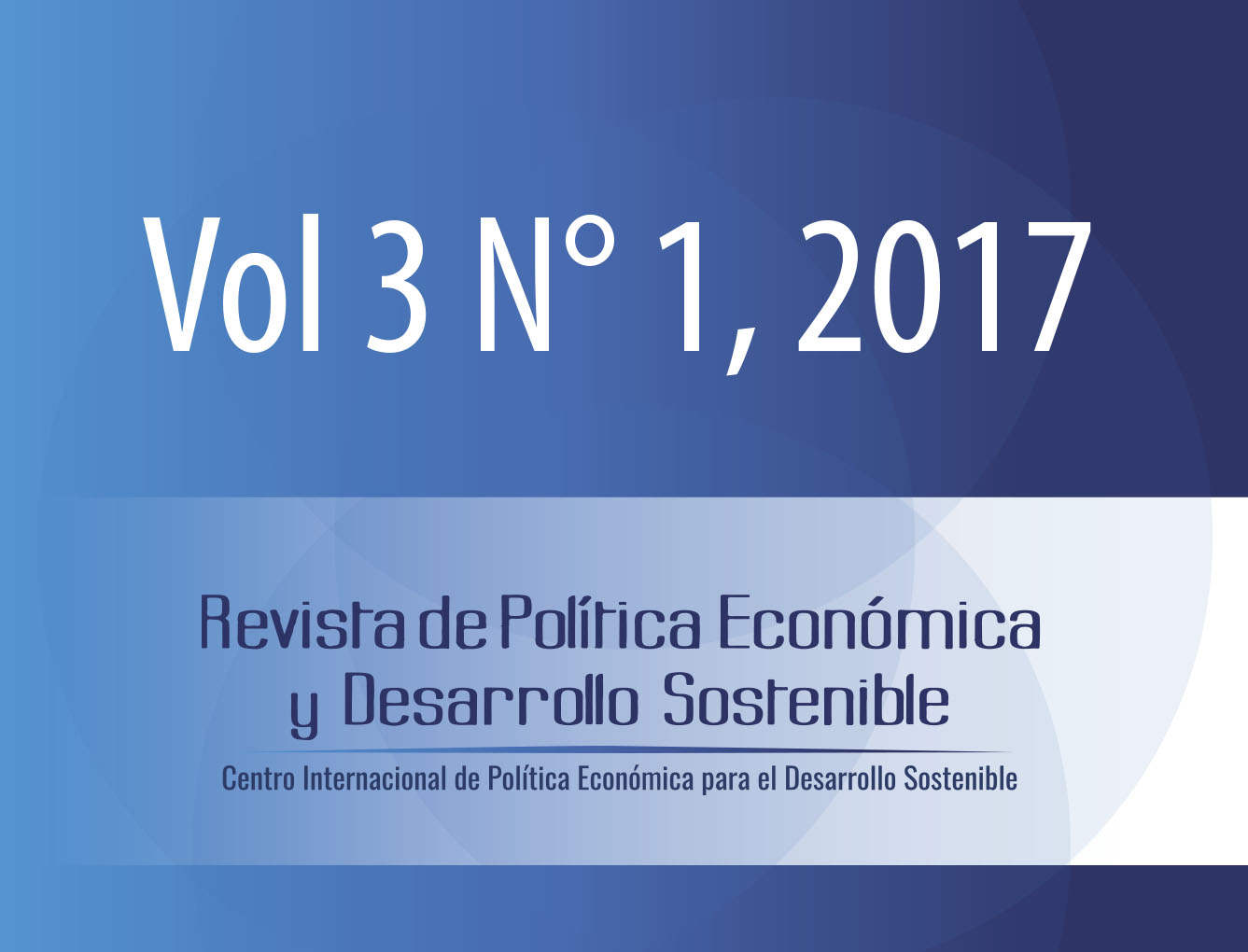Mapping Environmental and Socioeconomic impacts of hydrometeorological hazards across Central America. Study case: Honduras
DOI:
https://doi.org/10.15359/peds.3-1.2Keywords:
Climate, impacts, hydrometeorology, Honduras, Central AmericaAbstract
Hydrometeorological hazards have historically affected Central America and significantly impacted the isthmus. However, the spatial distribution of those impacts is heterogeneous and depends on several factors, such as storm trajectories and community vulnerability. To address the spatial distribution of impacts related with historical events, Honduras was used as a case study. This paper was aimed at identifying the municipalities most impacted by the hydrometeorological events and at studying their correlation with socioeconomic
variables. Impacts recorded from 1919 to 2012 were collected from the DesInventar and EM-DAT databases. Data was georeferenced using a Geographical Information System and the information was disaggregated at
local government scale. Spearman spatial correlation were calculated between physical variables and socioeconomic indices. The municipalities that reported more impacts included La Ceiba, Choluteca, Francisco Morazán and Yoro. Three hazards were found and the most important regarding impacts: cold fronts or outbreaks, tropical cyclones and easterly waves. The first type was more common during boreal winter, while the last two hazards were normally found during boreal spring-summer-autumn. Population and poverty were the social variables with the highest correlation with impacts. The analysis showed that spatial distribution of impacts related with hydrometeorological causes cannot be explained solely by climate causes. Therefore, other variables, such as socioeconomic should also be considered in analyses of these types of impact.
References
Alfaro, E. J. & Cortés, J. (2012). Atmospheric forcing of cool subsurface water events in Bahía Culebra, Gulf of Papagayo, Costa Rica. Revista de Biología Tropical, 60 (Suppl. 2), 173-186. Retrieved from: http://www.scielo.sa.cr/scielo.php?script=sci_arttext&pid=S0034-77442012000600012
Alfaro, E.J. & Pérez-Briceño, P.M. (2014). Análisis del impacto de fenómenos meteorológicos en Costa Rica, América Central, originados en los mares circundantes. Revista de Climatología, 14, 1-11. Retrieved from: http://webs.ono.com/reclim9/reclim14a.pdf
Alfaro, E.J. & Quesada, A. (2010). Ocurrencia de ciclones tropicales en el Mar Caribe y sus impactos sobre Centroamérica. Revista Intersedes,11 (22), 136-153. Retrieved from: http://
www.redalyc.org/html/666/66620589007/
Alvarado, L., (2001). Boletín Meteorológico Mensual. Resumen sinóptico de enero, 2001:5-8. San José, Costa Rica: Instituto Meteorológico Nacional, Ministerio de Ambiente y Energía,
Alvarado, L. F. & Alfaro, E. J. (2003). Frecuencia de los ciclones tropicales que afectaron a Costa Rica durante el siglo XX. Tópicos Meteorológico y Oceanográficos, 10(1), 1-11.Retrieved
Amador, J.A. (2008). The Intra-Americas Sea Low-level Jet, Overview and Future Research. Annall of the New York Academy of Science, 1146:153-188. doi:https://doi.org/10.1196/
annals.1446.012
Amador, J. A. (2011). Socio-economic impacts associated with meteorological systems and tropical cyclones in Central America in 2010. In: State of the Climate in 2010, Special Supplement to the Bulletin of the American Meteorological. Society, 92(6), https://journals.ametsoc.org/doi/abs/10.1175/1520-0477-92.6.S1
Amador, J. A. & Alfaro, E. J. (2014). Weather and climate socio-economic impacts in Central America for the management and protection of world heritage sites and the Diquís Delta
culture in Costa Rica (a case study). Advances in Geosciences, 35, 157–167. doi:https://doi.org/10.5194/adgeo-35-157-2014
Amador, J. A., Alfaro, E. J., Lizano, O.G. & Magaña, V.O. (2006). Atmospheric forcing of the eastern tropical Pacific: A review. Progress on Oceanography, 69 (2-4), 101–142. doi:https://
doi.org/10.1016/j.pocean.2006.03.007
Amador, J.A., Alfaro, E. J., Hidalgo,H & Calderón, B. (2011). Central America. In: State of the Climate in 2010, Special Supplement to the Bulletin of the American. Meteological. Society
(6). Retrieved from:https://journals.ametsoc.org/doi/abs/10.1175/1520-0477-92.6.S1
Amador, J.A., Alfaro, E. J., Rivera, E. & Calderón, B. (2009). Central America. In: State of the Climate in 2008, Special Supplement to the Bulletin of the American Meteorological.
Society 90(8). Retrieved from: https://journals.ametsoc.org/doi/pdf/10.1175/BAMS-90-8-
StateoftheClimate
Brenes, C. L., Coen, J. E., Chelton, D. B. , Enfield, D. B., León, S. & Ballestero D. (2003). Wind driven upwelling in the Gulf of Nicoya, Costa Rica. International Journal of Remote
Sensing, 24 (5), 1127-1133. doi:https://doi.org/10.1080/0143116021000028632
Cardona, O.D., M. van Aalst, J., Birkmann, M., Fordham, G., McGregor, R., Pérez, R. S. Pulwarty,E. L., Schipper, F. & Sinh, B. T. (2012). Determinants of risk: exposure and vulnerability. In
CB. Field, V. Barro, TF .Stocker, D .Qin, DJ .Dokken, KL. Ebi, MD. Mastrandrea, KJ .Mach,GK. Plattner, SK .Alle, M.Tignor, PM. Midgley, (Eds. Managing the Risks of Extreme Events
and Disasters to Advance Climate Change Adaptation (pp. 65-108).New York: Cambridge University Press, doi:https://doi.org/10.1017/CBO9781139177245.005
Chinchilla, G. (2008). Comentario meteorológico de Octubre de 2008. Boletín Meteorológico. XXXIII, Octubre 2008. Instituto Meteorológico Nacional. San José, Costa Rica. Retrieved
from:http://www.imn.ac.cr/boletin_meteo/historial/2008/BMET102008.pdf
Chinchilla G., E. Quirós, & Stolz, W. (2010). Resumen meteorológico mayo de 2010. Boletín Meteorológico, Instituto Meteorológico Nacional. San José, Costa Rica. Accessed 20 March
Retrieved from:http://www.imn.ac.cr/boletin_meteo/historial%20boletines.html
Centre for Research on the Epidemiology of Disasters [CRED]. (2009). About: EM-DAT, TheInternational Disaster Data Base. Centre for Research on the Epidemiology of Disasters.
Retrieved from: http://www.emdat.be/about
Desinventar, (2013). What is DesInventar. Network of Social Studies in the Prevention of Disasters in Latin America. Retrieved from: http://www.desinventar.org/en/desinventar.html]
Enfield, D.B. & Alfaro, E. J. (1999). The dependence of Caribbean rainfall on the interaction of the tropical Atlantic and Pacific Oceans. Journal of Climate, 12, 2093-2103. https://doi.
org/10.1175/1520-0442(1999)012<2093:TDOCRO>2.0.CO;2
Enfield, D.B., Mestas, A. M., Mayer, D. A. & Cid-Serrano, L. (1999). How ubiquitous is the dipole relationship in tropical Atlantic sea surface temperatures? Journal of Geophysical Research,
(C4), 7841-7848. https://doi.org/10.1029/1998JC900109
Fallas, J.C. & Oviedo, R. (2003). Temporales. Chapter III. In: Fenómenos atmosféricos y cambio climático, visión centroamericana. Instituto Meteorológico Nacional, San José, Costa Rica.
Ferreira, S., Hamilton, K. & Vincent, J. R. (2011). Nature, Socioeconomics and Adaptation to Natural Disasters: New Evidence from Floods. The World Bank Policy Research Working
Papers; Washington, D.C. https://doi.org/10.1596/1813-9450-5725
Flores, M., H. Lovo, W. Reyes, and Campos, M. (2009). Cambios en la pobreza y concentración del ingreso en los municipios de Honduras: desde 1988 a 2001. Documento de Trabajo N°50. Programa Dinámicas Territoriales Rurales. Rimisp, Santiago, Chile.
García-Solera, I. & Ramírez, P. (2012). Central America’s Seasonal Climate Outlook Forum. The Climate Services Partnership. Retrieved from: http://climate-services.org/resource/centralamerican-
climate-outlook-forum
García-Urquía, E. & Axelsson, K. (2015). Rainfall thresholds for the initiation of urban landslides in Tegucigalpa, Honduras: An application of the critical rainfall intensity. Geografiska
Annaler: Series A, Physical Geography, 97, 61–83. doi: https://doi.org/10.1111/geoa.12092
González, C. (1999). Climatología de frentes fríos que han afectado Cuba desde 1916-1917 hasta 1996-1997. Revista Cubana de Meteorología, 66: 15-19.
Grover-Kopec, E.K. (2006). Central America and the Caribbean. In: State of the Climate in 2005, Special Supplement to the Bulletin of American Meteorological Society, 87, S68.
Guinea-Barrientos, H.E., Swain, A., Wallin, M. B. & Nyberg, L. (2015). Disaster management cooperation in Central America: the case of rainfall-induced natural disasters. Geografiska
Annaler: Series A, Physical Geography, 97, 85–96. doi:https://doi.org/10.1111/geoa.12095
Hidalgo, H. & Alfaro, E. J. (2012). Some Physical and Socio-economical aspects of Climate Change in Central America. Progress in Physical Geography, 36(3), 380 – 399. doi:https://
doi.org/10.1177/0309133312438906
Hidalgo, H. G. & Alfaro, E. J. (2015). Skill of CMIP5 Climate Models in Reproducing 20th Century Basic Climate Features in Central America. International Journal of Climatology.
: 3397–3421.doi: https://doi.org/10.1002/joc.4216
Hidalgo, H. G., Alfaro, E. J. & Quesada-Montano, B. (2017). Observed (1970-1999) climate variability in Central America using a high-resolution meteorological dataset with potential for climate
change studies. Climatic Change 141, 13-28. doi:https://doi.org/10.1007/s10584-016-1786-y
Hidalgo, H.G., Amador,J. A., Alfaro, E. J. & Quesada, B. (2013). Hydrological climate change projections for Central America. Journal of Hydrology, 495:94-112. doi:https://doi.
org/10.1016/j.jhydrol.2013.05.004
Instituto Hondureño de Ciencias de la Tierra [IHCIT, (2012). Atlas climático y de gestión de riesgo de Honduras. Universidad Nacional Autónoma de Honduras.
IHMC.(n.d). Información por Departamento y Municipio. Secretaría de Estado del Despacho Presidencial. Retrieved from:http://cmapspublic.ihmc.us/rid=1L65T2ZB4-CWT0Q5-
B01/Departamentos%20y%20municipios%20de%20Honduras.pdf
Intergovernmental Panel on Climate Change [IPCC]. (2014). Summary for policymakers.In C. Field, V. Barros, D. Dokken, K. Mach, M. Mastrandrea , T. Bilir …& LL. White
(Ed.).Climate Change 2014: Impacts, Adaptation, and Vulnerability. Part A: Global andSectoral Aspects (pp. 1-32). Cambridge: Cambridge University Press.
Intergovernmental Panel on Climate Change [IPCC]. (2012). Managing the Risks of Extreme Events and Disasters to Advance Climate Change Adaptation. A Special Report of Working
Groups I and II of the Intergovernmental Panel on Climate Change, Vol. 1. Cambridge: Cambridge University Press. Retrieved from: https://www.ipcc.ch/pdf/special-reports/srex/SREX_Full_Report.pdf
Jongman, B., Winsemius, H.,Aerts. J., Coughlan de Perez, E., van Aalst, M., Kron, W. & Ward,P. J. (2015). Declining vulnerability to river floods and the global benefits of adaptation.PNAS, 112 (18). doi:https://doi.org/10.1073/pnas.1414439112
Koks, E.E., Jongman, B., Husby, T. G. & Botzen, W. J. W. (2015). Combining hazard, exposure and social vulnerability to provide lessons for flood risk management. Environmental
Science and Policy, 47, 42–52. doi:https://doi.org/10.1016/j.envsci.2014.10.013
Kron, W. (2005). Flood Risk = Hazard • Values • Vulnerability. Water International, 30 (1),58–68.doi:https://doi.org/10.1080/02508060508691837
Magaña, V., Amador, J. A. & Medina, S. (1999a). The Midsummer Drought over Mexico and Central America. Journal of Climate, 12:1577-1588. doi:https://doi.org/10.1175/1520-
(1999)012<1577:TMDOMA>2.0.CO;2
Magaña, V., Pérez, J., Vázquez, J., Carrisoza, E. & Pérez, J. (1999b). Los Nortes. Chapter 2. El Niño y el clima, 34-41. In: V.O. Magaña (ed.). Los Impactos de El Niño en México. México
D.F., México: UNAM
Maldonado, T., Alfaro, E. J., Fallas, B. & Alvarado, L. F. (2013). Seasonal prediction of extreme precipitation events and frequency of rainy days over Costa Rica, Central America, using
Canonical Correlation Analysis. Advances in Geosciences, 33: 41-52. doi: https://doi.org/10.5194/adgeo-33-41-2013
Mechler, R., & Bouwer, L. M. (2014). Understanding trends and projections of disaster losses and climate change: is vulnerability the missing link?. Climate Change, 133(1):23-35. https://doi.
org/10.1007/s10584-014-1141-0
Muñoz, Á.G., Ruiz-Carrascal, D., Ramírez, P., León, G., Quintana, J., Bonilla, A., Torres, W.,Pastén, M. & Sánchez, O. (2012). Risk Management at the Latin American Observatory,
Risk Management-Current Issues and Challenges. InTech, Chapter 22. https://doi.org/10.5772/50788
Narváez, L., Lavell, A. &Pérez, G. (2009). La Gestión del riesgo de desastres: un enfoque basado en procesos. Comunidad Andina. Accessed 3 February 2016. Retrieved from:http://www.
comunidadandina.org/predecan/doc/libros/PROCESOS_ok.pdf
Neri, C. & Magaña, V. (2016). Estimation of vulnerability and risk to meteorological drought in Mexico. Weather, Climate and Society, 8: 95-110.doi: https://doi.org/10.1175/WCAS-D-15-0005.1
Peña, M., & Douglas, M. W. (2002). Characteristics of Wet and Dry Spells over the Pacific Side of Central America during the Rainy Season. Monthly. Weater Review, 130, 3054-3073.
doi:https://doi.org/10.1175/15200493(2002)130<3054:COWADS>2.0.CO;2
Pérez-Briceño, P. M., Alfaro, E., Hidalgo, H. G. & Jiménez, F. (2016). Distribución Espacial de impactos de eventos hidrometeorológicos en América Central. Revista de Climatología, 16,63-75. Retrieved from:http://webs.ono.com/reclim11/reclim16e.pdf
Retana, J.A. (2012). Eventos hidrometeorológicos extremos lluviosos en Costa Rica desde la perspectiva de la adaptación al cambio en el clima. Tópicos Meteorológicos y Oceanográficos,
(1):52-64. doi:https://doi.org/10.15359/rca.44-2.1
Serra, Y. L., N. K. George, and Kevin, I. H. (2010). Tracking and Mean Structure of Easterly Waves over the Intra-Americas Sea. Journal of Climate, 23:4823-4840. doi:https://doi.
org/10.1175/2010JCLI3223.1
Taylor, M.A., and Alfaro, E. J. (2005). Climate of Central America and the Caribbean. In:Encyclopedia of World Climatology. John E. Oliver (ed.), Springer, Netherlands, pp183-189.
Available in: http://www.springer.com/gp/book/9781402032646
Taylor, M. A., Centella, A., Charlery, J., Borrajero, I., Bezanilla, A., Campbell, J, … & Watson,R. (2007). Glimpses of the Future: A Briefing from the PRECIS Caribbean Climate Change
Project. Caribbean Community Climate Change Centre. Available in: http://precis.metoffice.com/docs/CCCCC_PRECIS_REPORT.pdf
United Nation Office for Disaster Risk Reduction [UNISDR] (2015). Making Development Sustainable: The Future of Disaster Risk Management. Global Assessment Report on Disaster Risk Reduction. Geneva, Switzerland: UNISDR. Available in: http://www.
preventionweb.net/english/hyogo/gar/2015/en/home/download.html
Velásquez, A. & Rosales, C. (1999). Escudriñando en los desastres a todas las escalas. Concepción, metodología y análisis de desastres en América Latina utilizando DesInventar. Cali, Colombia:
Red de Estudios Sociales en Prevención de Desastres en América Latina – LA RED. Available in: http://www.desenredando.org/public/libros/1999/edete/edte1_v.1.0-ago-30-2001.pdf
Wilches-Chaux, G. (1993). La Vulnerabilidad Global. In A. Maskrey (Ed). Los Desastres no son naturales. Red de Estudios Sociales en Prevención de Desastres de América Latina - La Red. Available in: http://www.desenredando.org/public/libros/1993/ldnsn/html/cap2.htm
Westerberg, I., Walther, A. , Guerrero, J. L., Coello, Z., Halldin, S, Xu, C. Y., & Lundin, L. C. (2010). Precipitation data in a mountainous catchment in Honduras: quality assessment and spatiotemporal characteristics. Theorical and Applied Climatology, 101, pp. 381–396.doi:https://doi.org/10.1007/s00704-009-0222-x
Zárate-Hernández, E. (2013). Climatología de masas invernales de aire frío que alcanzan Centroamérica y el Caribe y su relación con algunos índices Árticos. Tópicos Meteorológicos
y Oceanográficos, 12(1),35-55.
Zebiak, S.E., Orlove, B., Muñoz, A. G., Vaughan, C., Hansen, J., Troy, T., Thomson… & Garvin, S. (2014). Investigating El Niño-Southern Oscillation and society relationships .WIREs.
Climate Change, 6, pp.17–34.doi: https://doi.org/10.1002/wcc.294







